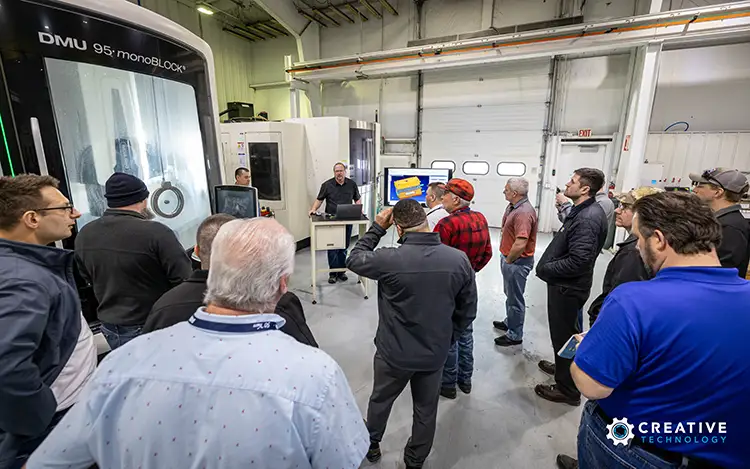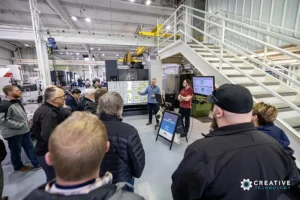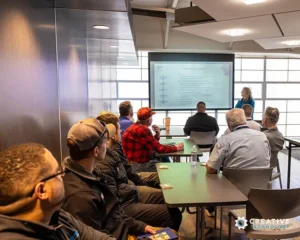
By Liz Stevens, writer, The American Mold Builder
Byrne Tool + Design recently hosted an AMBA plant tour of the company’s Rockford, Michigan, operation, during which the manufacturer discussed and demonstrated an array of business practices to leverage creativity – as opposed to spending capital – to remain competitive and profitable. For this View from 30, The American Mold Builder followed up with Mike McLean, general manager at the company, for insight into the most valuable aspects of Byrne Tool’s efforts to use its existing resources and technologies to the fullest.
Byrne Tool + Design began in 1974 as Bylsma Tool, headed and staffed by founder Pete Bylsma. The company was moved to Rockford in 1984, purchased by Norman Byrne in 1997, initially called Byrne Tool & Die and renamed Byrne Tool + Design (BT+D) in 2015. The company produces injection mold tools for manufacturers of automotive, defense, medical and consumer goods. Byrne Tool has a 3D printing-equipped full-service design center, a range of injection molding presses for in-house sampling, a 17-strong day shift including two company veterans with 40 plus years of experience, and automation-enabled lights-out machining.

McLean described his role at Byrne Tool and the company’s ethos. “As general manager,” said McLean, “I provide leadership and management to the organization so we can meet strategic objectives and operational excellence goals. I make recommendations for increasing our use of technology and resources, and I define initiatives for our team to meet established goals, often developing tools to increase company efficiency and reduce risk.” BT+D approaches workforce development and training, lean manufacturing and other resource enhancements with a long-held culture. “The company has a legacy of continuous improvement,” McLean explained. “We have a saying here – ‘Honor tradition and pioneer change.’ Lean manufacturing has been a staple of Byrne Tool’s growth for the last 25 years. We began with regular 5S and Common Sense Manufacturing events (multi-day problem-solving sprints). More recently, our initiatives have included automating the capture of real-time KPIs, and the use of the low-tech and highly effective SQDC boards (visual project management whiteboards).”
A Brand Promise
BT+D’s commitment to efficiency and excellence is found in every aspect of the company’s workflow, including marketing and customer communications. As McLean described it, “Byrne Tool has a brand promise of tooling done on time and right the first time. When we deliver on that promise it allows us to retain existing customers and win referral business from satisfied customers.” McLean asserted that a solid referral from a satisfied customer is the path of least resistance in finding qualified prospects for new business. “Once we gain an introduction to a new customer,” said McLean, “our goal is to have them visit our shop. Once they’ve visited us, we enjoy a high prospect-to-customer conversion rate.”

The company gauges marketing success via tried-and-true methods. “This is one area in which we really honor tradition,” McLean said, “Instead of putting money toward AdWords and PPC campaigns that convert form completions, we measure sales growth by segment and customer retention. Our new customer sales have increased 30% since 2019, in no small part due to referrals.” When it comes to customer communications, Byrne Tool provides detailed build schedules to its customers for all new tooling and larger engineering changes. BT+D taps technology to offer customers beyond-the-norm access and communication: “We developed an online customer portal that each customer can use to see its job status in relation to the agreed-upon schedule,” said McLean. “This wasn’t intended to reduce customer interaction, but rather to standardize how information is shared, so customer conversations are more productive and less ambiguous.”
McLean explained that cutting lead times is an additional factor that improves the customer experience. “We made significant improvements to our scheduling processes, planning each component of a tool complete through our facility,” he said. “The method of scheduling that we use allows us to identify critical paths for our projects to get them on schedule and highlight float time for different components. This makes it easier to see where drop-in repairs and engineering changes can be pushed forward or where we can compress lead times.”
The Magic of Job Planning
At BT+D, job planning is another aspect of business that has been improved. “Our job planning has increased tremendously,” said McLean. “Instead of viewing a job as an individual unit in a silo managed by one mold builder, we document our routing and schedules digitally, bringing transparency to the organization’s core functions and improving team dialogue.” The software in use for job planning is Smartsheets. “The magic, however, is in the planning process, as opposed to the tool used,” McLean said. “We want to make better planners who can react dynamically when things change. Eisenhower famously said, ‘Plans are worthless, but planning is everything.’ I strongly believe that.”
The company also keeps an eye on outsourced work. “We generate reports to see what is planned to be contracted outside,” McLean said. “This has helped us increase efficiencies in logistics and improve our communication with vendors.”
The mix of lights-out manufacturing and operator-monitored production at BT+D is fluid and job-dependent. “Our scheduling and planning are not prescriptive,” said McLean. “That is, we don’t dictate down to the hour which components should be completed at which machine, so operators have the freedom to sequence as they see fit.” Parts with multiple setups, for example, or parts that require operator interaction are run during the day, while longer programs are run at night to optimize lights out. This fluid strategy also gives the company the freedom to move jobs around to expedite repairs.
Working Toward a Common Purpose

BT+D has what it calls a self-directed workforce. “Our organization is flat,” McLean explained. “No one is dictating tasks or calling all the shots. We don’t have a foreman or supervisors.” The company’s work plans specify the required timelines and the milestones to be hit. “But if a CNC operator has four components to machine,” said McLean, “the operator has the freedom to sequence the job to optimize the run time. Mold builders are given freedom to prioritize their jobs to create an efficient schedule.” BT+D’s core business hours are 8 a.m. to 4 p.m. but with flexibility built in. “Some people,” McLean said, “start at 5 a.m. so they can get home in time to meet their kids at the afternoon school bus. Others like a later start time and work later accordingly. This allows us to have daily coverage through most departments from 5 a.m. to 5 p.m.; combined with our lights out, we have the operating efficiency of two shifts but with the staffing of only one. That is what we mean by a self-directed workforce – it is not other-directed.”
That kind of autonomy extends to the use of digital tools at BT+D. “Everyone has their own computer and the requisite skills to use technology effectively and professionally,” McLean said. “With design data shared throughout the organization, we foster collaboration amongst coworkers. This collaboration, in turn, allows for creative problem solving.” McLean acknowledged that there are risks associated with having technology so ingrained in the company’s operations. “We have quarterly cyber security training. We also have internal phishing campaigns designed to snare users and train them on how to spot and report these risks. This also highlights vulnerabilities to address before they become a problem.” Effective job reporting also puts the company in a position to identify emerging problems as early as possible. “We have a daily huddle with department representatives and job leaders in which our goal is to identify risks to our projects and discuss how to keep them on track,” said McLean. “We have real-time reports on our schedules to see where projects could be slipping, but also to balance capacity.”
In addition, the company fosters its next generation of workers through an active apprenticeship program and offers tuition reimbursement for team members who would like to further their education. DiSC personality and communication style training and scientific problem-solving exercise programs have been conducted, and the company delivers annual CAD training and refresher courses for employees – all of which are a key part of building a self-directed workforce and striving toward one common purpose as a company.
Manufacturing Simplified
It is no surprise that lean production is practiced at BT+D. The company has, for example, been paperless for over 10 years. “There are no job riders or other paperwork floating around containing technical data,” McLean explained. “Our experience is, once something is printed, it is no longer revision controlled. Instead, we maintain all data in the CAD model: the model data is the single source of truth, and all employees have training and access to the CAD model. If a feature exists in the mold, it exists in the CAD model. We use color codes and layers in the CAD system to communicate tolerancing and other information.”
How does the company measure success in this area? “We rigorously track scrap and rework, and follow back to the root cause for almost all issues,” said McLean. “Since going paperless, design revision-related rework has been reduced significantly by instantly giving access to the most up-to-date specs.”
Continuing to Dig Deeper
Through it all, says McLean, an important lesson has been learned. “Everyone must be a leader. This requires technical understanding of the operation, diligence to follow critical processes, courage to point out problems and vulnerability to ask for help.” What’s up next for Byrne Tool + Design? “We continue to sharpen the knife… We’ll be digging deeper into finding methods and resources to reduce non-value-added work. We will continue to improve our operations and financial analysis and reporting, and ultimately continue to deliver on our brand promise.” Kudos and many thanks to BT+D for its willingness to share valuable strategies and methods.
More information: www.byrne-tool.com.


